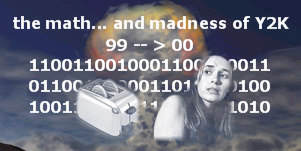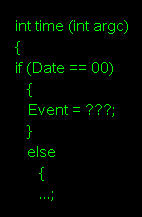
1999 was a very exciting
and anxious time! I got caught up in it myself and even bought one of those Millennium
countdown clocks (it still works and sits on my desk as I’m writing this). The coming
New Year’s celebration had been anticipated for over a decade, but the potential Y2K
crisis gave it a dimension worthy of a blockbuster Hollywood sci-fi film.
Articles on IT sites and in magazines about the problem gradually appeared, then
increased, during the 90s. By 1998 they were beginning to take on a hyperbolic
tone and it was hard to determine what might be the reality from all the predictions
that were being made.
I vividly remember the moment when I knew that the press was indulging in exaggeration.
I was sitting in the customer waiting room of a local electric utility, waiting for
some new metering equipment for a job I was doing. I was passing time reading a
prominent news magazine. The article was about the year-2000 issue and the author
was explaining that almost everything electronic had a microprocessor in it, and was
therefore vulnerable to the Y2K glitch. Listed among these things were microwave
ovens and toasters… Toasters?
"I knew someone who stopped paying all their bills because
they actually thought it was going to be
the end of the world."
Being an electrician, and someone who loved to take things apart, I knew that most
toasters – perhaps 99% - operated with a bi-metal release mechanism. This was a strip
composed of two bonded metals with dissimilar coefficients of expansion. When the
strip got hot one metal expanded more than the other, causing it to bend and release
the spring-loaded toast tray within the appliance. There was no microprocessor, no
program code, and it sure didn’t know or care what year it was. The author had clearly
gone for the “big story” effect.
So what was the real scope of Y2K? Was it really a looming disaster or just a bunch
of made-up hype? Like most debated issues the truth was somewhere in the middle. To
test my own PC (an 80386DX running Windows 3.1 – no laughing please!) I booted into
the BIOS then set the date for 12/31/1999 and the time for 11: 55 p.m. I re-booted
the computer into Windows and opened several programs. I proceeded to use the computer
as I normally would until the time had passed well into “1/1/2000”. There were no
problems and a re-inspection of the BIOS showed the four-digit year of 2000. I came
to the conclusion that this was mostly hype.
To get a clearer picture of Y2K ten years later, I contacted Chris Kremer with
CVK Technical Consulting in Buffalo, NY. His perspective of Y2k turned out to be somewhat different
from my own, mainly since his experience was with custom-written legacy software for
larger businesses. Here is what he shared with me.
Q. Do you remember how you first became aware of the year-2000 issue?
I became aware of the Y2K issue in 1990 during a Y2K awareness conference in Reston
Virginia while working on a federal government contract. I learned that many programmers
had used 2 digits for recording year data instead of 4 and that this was going to cause many problems.
Q. Were your clients anxious about it or did you have to persuade them to
take preventative measures?
 All of my clients took the issue very seriously and began to conduct audits to identify all of the
applications that were going to be affected by the issue.
All of my clients took the issue very seriously and began to conduct audits to identify all of the
applications that were going to be affected by the issue.
Q. Was there a point where you thought the media may have been exaggerating the scale of the problem?
No, because I was exposed to many diversified proprietary software applications and I understood
how they functioned. I understood programming and date mathematics. By the time the media was reporting
the issue, I knew and understood the effects of having the date rolled back 100 years and what that
could do to these systems. I knew that any applications that used date codes for calculating
were going to be a problem. I had already worked on many projects that involved conducting simple
experiments by changing the year in software applications to 2001 and beyond and noting the results.
Q. Do you think IT vendors exploited the fear to sell new equipment and software?
No, but I would say that the whole Y2K issue was the result of the human condition. Humans are flawed
and many do not think about the future. When programming complex software it was shortsighted
to use a 2-digit-year field instead of 4. If 4 digits were used in every application
that was developed, then the issues would have never existed. Some people may even say that it was
planned obsolescence; in a few cases I believe that it was. For the majority of cases it was human
error. Think of a bank -- they operate their entire production from date mathematics and many banks
employ their own in-house software development team. There is no profit in developing a banking
application that is limited to 2 digit date codes. Not all banks had the problem; the ones that were
affected had to spend a lot of money to fix the flaw.
Q. What computer systems do you know of that were actually affected?
Hardware was not the major issue; it was software that was affected. I know of hundreds of
applications that were affected including applications for payroll processing, industrial
manufacturing and production, project management, accounting, security systems, and medical systems --
the list goes on and on.
Q. Do you have any guess of how much preventative work was actually necessary?
Preventative is not the term that I would use. It does not take much work at all to be preventative,
namely, have a 4-digit year code in the software. The programmers with the flawed software should have been
preventative. The term that I would use is reactive, because companies had to spend hundreds of hours
auditing their systems to discover all of the applications that required work to correct the problem.
Once the issues were identified, they had to figure out (a) if it was worth doing minor changes or (b) if it would
be better to re-write the entire application and make other improvements along the way or (c) purchase and
implement new third party applications. It really was a big deal identifying and documenting the problems,
considering all of the options and then managing the solutions.
Q. What are the most extreme cases that you remember?
I knew someone who stopped paying all their bills because they actually thought it was going to be
the end of the world. They ended up losing their house and many of their personal possessions because
of this thinking. I also knew of some companies that were owned by multi-millionaires that were
so uninformed and cheap that they did nothing at all about the issue until their whole business was affected;
all of their employees were so stressed during January of 2000 that some actually quit.
All of these companies have since gone out of business.
Q. What do you think were important things to learn from this?
The success of any project is all about the personal philosophy of the people working on the project --
how they think as individuals, how they work as a team, what contributions they make during the project,
and how dedicated they are to achieving the end result.
Chris Kremer is an IT professional and owner of
CVK Technical Consulting
